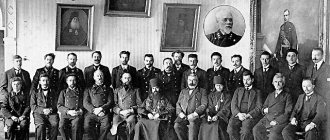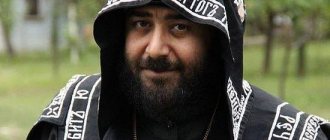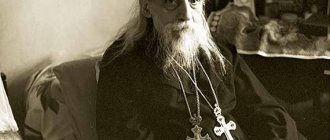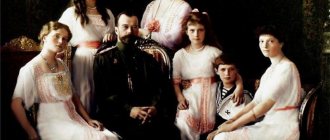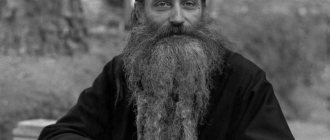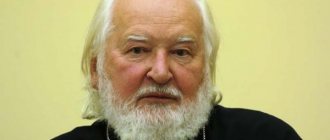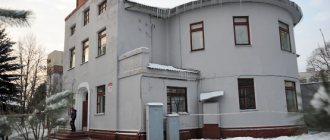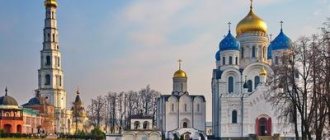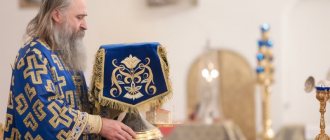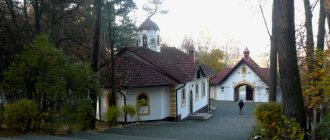| Sschmch. Seraphim (Zvezdinsky) |
Seraphim (Zvezdinsky)
(1883 - 1937), Bishop of Dmitrov, vicar of the Moscow diocese, hieromartyr Memory of August 13, in the Councils of New Martyrs and Confessors of the Russian Church, New Martyrs and Confessors of Radonezh and in the Councils of Moscow and Omsk Saints.
In the world, Nikolai Ivanovich Zvezdinsky, was born on April 7, 1883 in the family of the Edinoverie priest John and his wife Evdokia Vasilievna (nee Slavskaya) Zvezdinsky. On November 17, 1885, at the age of two, the boy was left without a mother.
Kolya was sent to study at a church school at the Edinoverie Church, and after graduating, in 1895, to the Zaikonospasskoe Theological School, on Nikolskaya Street. Since 1899, Nikolai Zvezdinsky has been a student at the Moscow Theological Seminary.
In the Cathedral of Christ the Savior in Moscow, Bishop Parthenius (Levitsky), who had recently been the rector of the seminary, ordained Nicholas as a reader and subdeacon.
In 1902, in his second year at the seminary, when Nikolai was 19 years old, he became seriously ill with lymphangitis, a disease then practically incurable, but was miraculously healed through prayer in front of the image of the not yet glorified Elder Seraphim, brought by the abbot of the Sarov Hermitage Hierotheus. The image of the meek old man forever became a family shrine and accompanied Vladyka Seraphim for almost his entire life.
After the miraculous healing of his son, Father John, according to the orders of the Holy Synod, compiled a troparion and kontakion [1] dedicated to the saint. Seraphim (not yet canonized).
Nikolai Ivanovich Zvezdinsky graduated from the seminary in 1905 as one of the best students and entered the Moscow Theological Academy.
Over the years of studying at the academy, Nikolai became firmly established in his choice of the monastic path. At the shrine of St. Sergius, together with his friend Vitaly Stavitsky (future Bishop Philip), he vowed to take monastic vows.
After his father's death in January 1908, Nikolai went to his father Alexy in Zosimov Hermitage. On September 26, 1908, after an all-night vigil, Nikolai Ivanovich was tonsured as a monk with the name Seraphim in honor of the Venerable Seraphim of Sarov.
| Archimandrite Seraphim (Zvezdinsky). Miracle Monastery, 1918. |
On the day of the Kazan Icon of the Mother of God, October 22, 1908, the rector ordained monk Seraphim as a hierodeacon, and on July 8, 1909, he was ordained as a hieromonk.
In the same year, he graduated from the Theological Academy with the title of master's candidate in theology and soon received an appointment to teach Church history at Bethany Seminary. He lived strictly, prayed a lot and fasted: 8 spoons of soup, according to the number of words of the Jesus Prayer: “Lord Jesus Christ, Son of God, have mercy on me, a sinner.” I divided small portions of lunch in half.
On September 21, 1912, Father Seraphim was transferred to the Moscow Theological Seminary to the position of teacher of homiletics and related subjects.
On June 10, 1914, Hieromonk Seraphim was elevated to the rank of archimandrite, appointed assistant to the abbot of the Chudov Monastery and relieved of his position as a teacher at the Moscow Theological Seminary.
From August 1914 to August 1915, he served as the capital's supervisor of parochial schools. In 1914, he was elected chairman of the society of banner bearers of the Cathedral Chudov Monastery.
In August 1918, he and his friend Bishop Arseny (Zhadanovsky) had to leave the monastery and move to a small convent, Seraphim-Znamensky Skete, to schema-abbess Tamar (Mardzhanova), the bishop’s loving spiritual daughter. Mother surrounded the exiles with care; Having a small house in the forest near the monastery, she arranged a monastery for them. Here, in complete solitude, they prayed and worked: they dug beds and chopped wood. Father Seraphim read the Holy Scriptures according to the rule of St. Seraphim: in a week - four Gospels, the Acts of the Apostles and the Epistles. Every day he concelebrated with Bishop Arseny in the cinnamon church in the name of St. Joasaph.
Bishop of Dmitrovsky
On January 3, 1920, on the day of St. Peter, Patriarch Tikhon consecrated Father Seraphim as Bishop of Dmitrov. During the festive dinner, Metropolitan Sergius (Stragorodsky), taking his tablespoon, remarked: “ I advise, Vladyka, to stock up on a spoon, you will have to go to prison. Don't forget this item, it will be very needed there
».
Patriarch Tikhon, admonishing Bishop Seraphim for his bishop’s work, said: “ Walk the apostolic path... wherever you have to walk, go on foot. Never be embarrassed by anything. Don't be afraid of inconveniences, endure everything. Do you think they burn incense to the bishop three times three times for nothing? No, not without reason. For his many labors and exploits, for his confessional illnesses and for preserving the Orthodox faith until he bled
»
During the years of service in Dmitrov, the bishop established the brotherhood of the Life-giving Cross of the Lord, which had the goal “ in prayerful unity to draw spiritual strength to create one’s life according to the commandments of our Lord Jesus Christ - to serve Christ and in Christ and for the sake of Christ to one’s neighbor
" Filial devotion to the holy Orthodox Church and obedience to all its laws was approved by the charter as the direct duty of the brothers. Brothers should especially try to implement the most important commandment of the Gospel: “Love one another.”
The archpastoral service of Bishop Seraphim was the affirmation and implementation of ardent love for Christ, Christ's love for one's neighbor and fidelity to the Orthodox Church. He raised his flock in the spirit of reverent attitude towards all church statutes, and demanded their strict observance from the clergy.
Once, when Bishop Seraphim came to his elder Alexy, he blessed him with a transparent, dark-red cross, like blood, and read the troparion of the holy martyr: “ And having been a communicant in character, and having been an apostle at the throne, you have gained your deed, inspired by God, in a vision the rise of this: for the sake of correcting the word of truth, and for the sake of faith you suffered even to the point of bloodshed
».
Arrests and exiles
| Bishop Seraphim of Dmitrov is in exile. Mid-1930s |
On the day of the Sign of the Most Holy Theotokos, December 10, 1922, Bishop Seraphim served a solemn service in Dmitrov for the last time.
A summons arrived - the bishop was summoned to Moscow. On December 12, having arrived in Moscow, Vladyka went to Lubyanka, where he was arrested. For nine days he and other priests were kept without food or light, then they were transferred to Butyrka prison for five months. The bishop’s body, eaten by lice, was covered with scabs, and the doctor could not apply the tube; he had to put paper on it. Heart attacks started. The bishop was transferred to a “neighbourhood”, where there was a semi-hospital regime, more air, walks and - the clergy of the Cathedral of Christ the Savior, but the arriving prosecutor, noticing the images of the Quick Hearer, St. Seraphim and other saints, stuck with bread to the wall near the bed of Bishop Seraphim, ordered the bishop to be transferred to shared cell. In Butyrki, Bishop Seraphim composed an akathist to the Suffering Christ the Savior: “ In bearing the saving cross, sent down to me by Your right hand, strengthen me, who am completely exhausted
».
On March 30, 1923, Bishop Seraphim was sentenced: “ Two years of exile in the Zyryansky region
».
In April, Bishop Seraphim was transferred from Butyrskaya to Taganskaya prison.
On May 14, 1923, the train took the bishop into exile in Ust-Sysolsk (now Syktyvkar).
Saying goodbye to his spiritual children, the Bishop wrote:
«
Thank God for everything. I celebrate, brightly celebrate the fourth month of my soul-saving imprisonment. I thank the Lord, and I thank you too, my dear ones in Christ Jesus, my beloved and ever-remembered children and children, for all your compassionate care for me, a sinner. May the Lord reward you a hundredfold in this age and especially in the future
».
On June 7, Bishop Seraphim, Chudovsky abbot Filaret (Volchan) and Dmitrovsky dean Father John Muravyov [2] were urgently sent by steamer to Vizinga, where they arrived on the morning of the third day. We looked for shelter for a long time, since no one wanted to take us into our home. They never found a house in Vising and settled in the village of Sredniy Kolyel.
While in exile, the Bishop celebrated the Divine Liturgy every day and read the entire liturgical circle without fail. During the day, he retired to prayer in a nearby forest. Here he had a hermitage and a round pulpit mound. The bishop’s cell became a church in the name of the icon of the Mother of God “Quick to Hear”; he had an antimension and an image on paper that hung at the head of his bunk during his imprisonment in Butyrki.
In the spring of 1925, his period of exile ended, and in May he was back in Moscow. Here he served as assistant to the Patriarchal Locum Tenens (Metropolitan Peter) until Metropolitan Peter was removed from his duties on November 11, 1925.
Vladyka moved to the Borisoglebskaya Anosina hermitage. Soon he resumed attacks of stone-liver disease, which occurred twice a month. Sometimes the pain, which brought him to the point of loss of consciousness, continued for nine hours.
On July 13, 1926, the bishop was summoned to the Lubyanka. At noon he returned and said: “ They demand leaving Moscow. They suggested Novgorod, I asked Diveev. I received an appointment to go to Diveev or Sarov for six months. They said: “We will organize a Synod, but you will interfere.”
».
On July 17, 1926, Vladyka arrived in Diveevo. On August 1, 1926, the day of the glorification of St. Seraphim, Bishop Seraphim went to Sarov for a holiday. When he returned to Diveevo, a representative of the Nizhny Novgorod NKVD arrived and announced: service in Diveevo was allowed, entry into Sarov was prohibited.
On September 22, 1926, he and other local residents were deprived of their freedom and placed in a prison in the city of Arzamas, from there they were transferred to Nizhny Novgorod, then again to Moscow, where he was able to inform Metropolitan Sergius about himself. He reports that he does not recognize the declaration of Metropolitan Sergius and asks to resign.
By the end of October, Father Seraphim moved to the city of Melenki. The Dmitrovites, having learned the new location of the bishop, visited him. The clergy, Dmitrov and Moscow, monastics and laity came. Vladyka was told that the authorities did not like frequent visitors, no matter how they took him away. “ Let them travel, they’ll take it anyway
", answered the bishop. Life flowed smoothly in Melenki for about five years. For five years the Bishop did not leave the gate.
On April 23, 1932, he was taken to prison; on April 25, the bishop was escorted to Moscow to the Lubyanka and placed in an internal isolation cell, where Bishop Arseny (Zhadanovsky) was already detained; he was soon released, but Bishop Seraphim remained in prison. In June, he was transferred from Lubyanka to Butyrka prison, and on July 7, 1932, a sentence was passed - three years of exile in Kazakhstan.
The Bishop and his novices arrived in Alma-Ata on August 1 and settled on a terrace in a closet. The thinness of the air affected the heart, causing severe attacks. Almost every two days they ran for the doctor: it seemed that the bishop was dying... It became cold on the terrace in the fall: abscesses, rheumatism, toothache, malaria began...
On November 10, 1932, the bishop was summoned to the OGPU and ordered to go to the city of Guryev.
On July 17, 1933, during the liturgy, a representative of the OGPU appeared - the bishop was transferred to Uralsk. They set up a cell-church here and began to serve constantly again, but soon the bishop fell ill with malaria. Terrible attacks were repeated every day, quinine did not help. He lost consciousness and came to his senses only after a few hours. The doctor warned each time about the possibility of death the following night. The attacks stopped after two months.
On Epiphany Eve, when Bishop Seraphim was preparing for the blessing of water, a representative of the OGPU came and announced that the exile was being transferred to live in Omsk.
On January 30, 1935, Vladyka arrived in Omsk. After five days in Omsk, the OGPU ordered to immediately leave for Ishim. Arrived there on February 3, 1935 at night. Here there was an old man, Alexander Pavlovich, who invited the bishop to live in a house with a front garden and an apartment on the second floor.
The summer of 1935 arrived. The term of exile ended, but the bishop did not receive release. The papers arrived only in the fall. When asked to choose a place of residence (minus six cities), Bishop Seraphim replied that he decided to stay in Ishim, where he was given a residence passport.
At the end of 1936, Bishop Seraphim wanted to accept the great schema, but he could not arrange tonsure.
Final stage
On the night of June 23-24, 1937, NKVD workers raided the house occupied by the bishop and at 5 o’clock in the morning they took him to Ishim prison. Vladyka was barely alive, heart attacks began again, an intestinal disease was added, and the temperature was 40°. In response to the programs, he wrote with a trembling hand, asking for help, but the prison guards said that the temperature did not get rid of the stage... On July 18, they allowed a visit, warning: “ Say goodbye forever. You'll never see him again
».
Vladyka was transported to Omsk prison. Here Bishop Seraphim spent nine days in a solitary cell, then again in an overcrowded cell, where there were renovationists, defrocked clergy, and criminals. Vladyka suffered from kidney stones and was in pain. In one of the notes he wrote: “ I am bright, cheerful and joyful. The Lord strengthens and inspires us with the consciousness of His righteousness, despite difficult conditions
».
On August 23, 1937, a troika under the NKVD Directorate for the Omsk Region sentenced Bishop Seraphim (Zvezdinsky) to death. On August 26, 1937, the sentence was carried out.
Views on church politics
Vladyka Seraphim possessed the steadfastness of an infant’s faith, fortitude, and uncompromisingness. He was irreconcilable with the Renovationist schism and with the ministers of the so-called “living church.” But he also treated Metropolitan Sergius’s political course strictly. Without causing a schism and without joining the opposition led by Metropolitan Joseph, Vladyka Seraphim belonged, like his friend, Bishop Arseny (Zhadanovsky), to those “who do not remember” Metropolitan Sergius at the Liturgy and refrained from joint participation in prayer with the “Sergians.”
| Sschmch. Seraphim, Bishop of Dmitrov |
Kolenka
April 7, 1883 at Fr. John's son Nicholas, the future martyr, was born. On this day, at the service in the Church the words were read: “My son! give your heart to me, and let your eyes observe my ways” (Proverbs 23:26). Later, Bishop Seraphim recalled these words and saw in them a prophetic meaning about his monastic calling.
When Kolenka was only 3 years old, his mother died. Father John had a hard time. He took the boy with him to services, despite the weather. During the night services, Kolya was overcome by sleep. When the boy grew up a little and learned to read, they placed a bench next to the lectern with the Book of Hours. Kolya read loudly and clearly, tried hard.
One day Kolya followed his father to the altar by mistake through the Royal Doors (this is forbidden for laymen). Everyone who saw this said that the boy would serve at the throne of God.
In general, there will be many such signs in the life of St. Seraphim. After the October Revolution, his confessor, Elder Alexy (Soloviev), “suddenly” read the troparion to the holy martyr over him: “And by character a communicant, and a vicar of the throne, having been an Apostle, you have gained your work, inspired by God, in a vision the sunrise; For this reason, correcting the word of truth and for the sake of faith, you suffered even to the point of bloodshed.”
Help from Seraphim of Sarov
Photo from the website brooklyn-church.org
After graduating from church school, Nikolai Zvezdinsky entered the Moscow Theological Seminary to study. During his second year at seminary, he became very ill. Doctors diagnosed lymphangitis, which is incurable. At that time, the Monk Seraphim of Sarov was not yet glorified, but the people were already revered as a saint. Hegumen of the Sarov Hermitage Hierotheus brought Kolya a small image of the venerable elder. Kolya fervently prayed to Saint Seraphim of Sarov for recovery.
After some time, a medical commission confirmed the fact of his complete healing. Father John wrote a letter of gratitude addressed to Father Hierotheus and sent this letter to Sarov along with a certificate of healing of Nikolai Zvezdinsky, certified by the signatures of doctors. Since then, the future Bishop Seraphim always kept with him this image of the saint.
Hieromartyr Seraphim (Zvezdinsky), Bishop of Dmitrovsky
Memorial Day: August 13(26)
The Zvezdinskys take their origin from the Bonefatiev family, Old Believers-bespopovtsev. John Gavrilovich Bonefatiev, the future father of Bishop Seraphim, burning with the desire for enlightenment, set off on foot from Soligalich to St. Petersburg and submitted a petition to the Most High for his inclusion in the Orthodox Church. He was accepted into Union with the Russian Orthodox Church, named Zvezdinsky and appointed to the position of reader at the church at the Volkov cemetery in St. Petersburg, where he discovered rare musical abilities and a beautiful voice.
In St. Petersburg, he married the daughter of a Edinoverie priest Evdokia Vasilievna Slavskaya, took holy orders and received a position as a priest in Rzhev. From the beginning of the 80s, Father John served in Moscow. As rector of the Trinity Church, Father John Zvezdinsky earned universal love and respect and was soon appointed dean of all Edinoverie churches.
On April 7, 1883, on Thursday of the sixth week of Great Lent, his son Nicholas, the future Bishop Seraphim, was born. In 1885 or 1886, the very young wife of Father John died, and Nikolai was left without a mother for three years. Father taught Kolya to love church services, temple, singing and reading.
He was sent to study at a church school at the Edinoverie Church, and after graduating, in 1895, to the Zaikonospasskoye Theological School, on Nikolskaya Street. Since 1899, Nikolai Zvezdinsky has been a student at the Moscow Theological Seminary. In 1902, in his second year at the seminary, when N. Zvezdinsky was 19 years old, he became seriously ill with lymphangitis - a disease then practically incurable, but was miraculously healed through prayer in front of the image of the not yet glorified Elder Seraphim, brought by the abbot of the Sarov Hermitage Hierotheus. In Sarov, Father John sent a certificate of healing certified by doctors and a letter of gratitude to Father Hierotheus. A year after this event, Nicholas became a witness and participant in the celebrations for the canonization and glorification of St. Seraphim of Sarov.
Nikolai Ivanovich Zvezdinsky graduated from the seminary in 1905 as one of the best students. After fervent prayer at the relics of St. Sergius, he passed the competition and was accepted into the Moscow Theological Academy for full support. Over the years of studying at the academy, Nikolai became firmly established in his choice of the monastic path. At the shrine of St. Sergius, together with his friend Vitaly Stavitsky (future Bishop Philip), he vowed to take monastic vows. At the same time, he became the spiritual son of the elder of the Zosimova Hermitage, Hieromonk Alexy (Soloviev). The elder lovingly accepted the pious young man under his leadership.
On the eve of Epiphany 1907, Nikolai’s father, Archpriest John Zvezdinsky, died. Fellow believers turned to Moscow Metropolitan Vladimir (Epiphany), the future holy martyr, with a request to install Nikolai Ivanovich as rector in his father’s place. But the bishop, seeing bright spiritual talents in Zvezdinsky, did not fulfill their desire.
Probably, in the Zosimova Monastery, Nikolai met the archimandrite of the Chudov Monastery, Arseny (Zhadanovsky), and soon became his frequent visitor. Father Arseny fell in love with a modest, spiritually minded student. I talked with him as with a friend, taking a keen interest in his life. Having decided to take monastic vows, Nikolai asked for blessings and prayerful help from his elder, Father Alexy, and blessings from Archimandrite Arseny. Father Arseny blessed him with the image of the Resurrection of Christ.
On September 26, 1908, after an all-night vigil, Nikolai Ivanovich was tonsured as a monk. He received the name Seraphim in honor of St. Seraphim of Sarov. His face shone with heavenly peace when, after tonsure, the monks approached him, asking: “What is your name, brother?”
On the day of the Kazan Icon of the Mother of God, October 22, 1908, the dedication of monk Seraphim to hierodeacon took place in the academic Church of the Intercession. And on July 8, on Kazanskaya the following year, 1909, the initiation into hieromonk took place. In the same year, he graduated from the Theological Academy with the title of master's candidate in theology and soon received an appointment to teach history.
On September 21, 1912, Father Seraphim was transferred to the Moscow Theological Seminary to the position of teacher of homiletics and related subjects.
On June 8, 1914, Archimandrite Arseny (Zhadanovsky) was consecrated Bishop of Serpukhov, vicar of the Moscow diocese, leaving him as vicar of the cathedral Chudov Monastery, and on June 10, Hieromonk Seraphim was elevated to the rank of archimandrite, appointed assistant to the vicar of the monastery and relieved of his position as a teacher at the Moscow Seminary . From August 1914 to August 1915, he served as the capital's supervisor of parochial schools.
Father Seraphim survived the shelling of the Kremlin in 1917 in the Chudov Monastery. The relics of St. Alexis, the main miracle shrine, from the beginning of the shelling on October 27/November 9, 1917, were transferred in a wooden coffin to the cave church, to the dungeon where 300 years ago the holy martyr Patriarch Hermogenes languished in prison. Here, under the endless roar of guns, Archimandrite Seraphim prayed for Russia day and night with all the brethren and guests of the Chudov Monastery, delegates of the Local Council - the future hieromartyr Metropolitan of Petrograd Veniamin (Kazan), Archbishop of Grodno Mikhail (Ermakov), Archbishop of Novgorod Arseny (Stadnitsky), Bishop Vladimir (Tikhonitsky) of Bialystok and with the Elder of Zosimov, Hieroschemamonk Alexy (Soloviev).
Representatives of the new government closed the Kremlin, and in the spring of 1918, orders began to be received to evict the monks. The internal life of the brethren also became more complicated. On July 26, 1918, on the day of the celebration of the Council of the Archangel Gabriel, Bishop Arseny and Archimandrite Seraphim left the Chudov Monastery forever.
After staying in the Zosimova Hermitage, Bishop Arseny and Archimandrite Seraphim moved in August 1918 to the Seraphim-Znamensky Skete to Schema Abbess Tamar (Marjanova), the loving spiritual daughter of the Bishop, who fearlessly sheltered him and selflessly served him. Mother surrounded the exiles with care; Having a small house in the forest near the monastery, she arranged a monastery for them. Here, in complete solitude, they prayed and worked: they dug beds and chopped wood. Father Seraphim read the Holy Scriptures according to the rule of St. Seraphim: in a week - four Gospels, the Acts of the Apostles and the Epistles. Every day he concelebrated with Bishop Arseny in the cinnamon church in the name of St. Joasaph.
At the end of the summer of 1919, Archimandrite Seraphim was summoned by His Holiness Patriarch Tikhon to Moscow.
On January 3, 1920, on the day of St. Peter, Metropolitan of Moscow, in the temple of the Trinity Compound, Holiness Patriarch Tikhon performed the episcopal hand of Archimandrite Seraphim in the service of Metropolitan of Vladimir Sergius (Stragorodsky), Archbishop of Kharkov and Akhtyr Nafanail (Trinity), Bishop of Vyatyskoye (phenomenon). Bishop of Alaska Philip (Stavitsky).
On January 25, 1920, the day of the holy martyr Tatiana, Vladyka Seraphim arrived in the destiny given to him by God. The three years he spent in Dmitrov remained unforgettable for the city residents. Fiery prayer, communion with those who have fallen away, seeking out the lost, consoling the elders, raising teenagers, unceasing teaching with the word of God - such was his ministry.
During the years of service in Dmitrov, the bishop established the brotherhood of the Life-giving Cross of the Lord, which had the goal “in prayerful unity to draw spiritual strength to create one’s life according to the commandments of our Lord Jesus Christ - to serve Christ and in Christ and for the sake of Christ one’s neighbor.” Filial devotion to the Holy Orthodox Church and obedience to all its laws were approved by the charter as the direct duty of the brothers. Brothers should especially try to implement the most important commandment of the Gospel: “Love one another.”
On Easter 1922, Bishop Seraphim was summoned to the Dmitrov executive committee. The people gathered and demanded his return: “Give us our ruler!” The authorities allowed him to go out onto the balcony, but even after that the people did not calm down and shouted. Then the bishop was released. The people solemnly chanted: “Christ is Risen!” returned to the cathedral with his shepherd. But soon a summons arrived: the bishop was summoned to Moscow, where he was arrested. After the interrogations were completed, he was transferred to Butyrka prison, where, due to the terrible conditions of detention, his health sharply deteriorated. In Butyrki, Bishop Seraphim composed an akathist to the Suffering Christ the Savior.
On March 30, 1923, on the day of Alexy the man of God, Bishop Seraphim was sentenced to two years of exile in the Zyryansky region. While serving his exile, Bishop Seraphim did not relinquish his archpastoral care for the Dmitrovites to the extent of the powers that were granted to the Moscow vicar at that time. Communication was carried out through letters.
In the spring of 1925, the period of exile ended. On the day of the Annunciation of the Most Holy Theotokos, a paper about liberation arrived, and on the same morning a telegram arrived about the death of Patriarch Tikhon. In Moscow he settled in the Danilov Monastery. The bishop began to have attacks of stone-liver disease.
After the death of His Holiness Patriarch Tikhon, according to his will, the now illustrious Metropolitan of Krutitsky Peter (Polyansky) took over the locum tenens position of the patriarchal throne and wished to make Bishop Seraphim his closest assistant. In September 1925, Vladyka moved to Moscow and settled near the Yauzsky Bridge, where he received the clergy every day.
On December 6, Metropolitan Peter left a testamentary order in which Bishop Seraphim was appointed chairman of the Council of His Eminence Moscow Vicars for the temporary management of the Moscow diocese. On December 9, 1925, Metropolitan Peter was arrested. The office was closed, the files were sealed, but already on December 10, 1925, Deputy Patriarchal Locum Tenens Metropolitan Sergius (Stragorodsky) appointed Bishop Peter (Zverev) as temporary administrator of the Moscow and Kolomna diocese.
In 1926 he was expelled from Moscow. His place of residence was Diveevo. In the fall of 1927, the closure of the Diveyevo monastery was announced. On the night of September 22, an armed detachment burst into the cells and sent Bishops Seraphim and Zinovy, Mother Abbess Alexandra, all the older sisters and clergy to the Arzamas prison. On October 8, Bishop Seraphim was released.
He submitted a request for dismissal from the staff to Metropolitan Sergius and moved to Melenki, Vladimir province. Since April 11, 1932, Bishop Seraphim was under house arrest. He was taken to prison on April 23 during an attack of biliary colic; on April 25, Vladyka was escorted to Moscow to the Lubyanka, where he was placed in an internal isolation cell. Bishop Arseny (Zhadanovsky) was already there, who was soon released, but Bishop Seraphim remained in custody. At the same time, many of his spiritual children were arrested. In June, he was transferred from Lubyanka to Butyrka prison, and on July 7, 1932, a sentence was passed: three years of exile in Kazakhstan.
In Alma-Ata, Vladyka’s health deteriorated sharply, and on November 10, 1932, he was summoned to the NKVD and ordered to go to the city of Guryev. He arrived there in the middle of winter, and already on July 17, 1933, he was arrested again and sent under escort to Uralsk to live.
Soon after his arrival in Uralsk, Vladyka fell ill with malaria. Terrible attacks were repeated every day, quinine did not help. Healing came unexpectedly on the day of remembrance of St. John of Tobolsk.
And again, in the middle of winter, an order was given within 24 hours to go to a new place - to Omsk, and 5 days after arriving in the city, the NKVD ordered to immediately leave for Ishim. We arrived there on February 3, 1935 at night. Easter has passed, summer has come. The term of exile ended, but the bishop did not receive release. The papers arrived only in the fall. When asked to choose a place of residence (minus six cities), Bishop Seraphim replied that he decided to stay in Ishim, where he was given a residence passport.
On June 23, 1937, GPU workers arrested the bishop. The last stage of Bishop Seraphim’s earthly life began with the Ishim prison. On August 23, 1937, the “troika” under the NKVD Directorate for the Omsk Region sentenced Bishop Seraphim (Zvezdinsky) to death, citing the fact that he “did not stop his counter-revolutionary activities” and in Ishim among believers “was reputed to be a holy man.” On August 26, 1937, the sentence was carried out.
Favorite preacher of Sergiev Posad
While attending seminary, Kolya was very worried that he would not be able to deliver sermons beautifully. Every day he prayed to the patron saint Nicholas the Wonderworker that the Lord would give him the gift of speech.
And a little later, Nikolai Zvezdinsky, a student at the Moscow Theological Academy, became one of the favorite preachers of all monks and residents of Sergiev Posad. When they found out that Kolya would give a sermon some day after the service, people said: “Let’s go to the academy, today student Nikolai Ivanovich Zvezdinsky will preach.”
Sergiev Posad. View of the Lavra. Colorized photo from the early 20th century. Photo from sovetsp.ru
Advice to the bishop from the metropolitan
Hieromartyr Seraphim (Zvezdinsky) in the rank of Bishop of Dmitrov, vicar of the Moscow diocese.
First half of the 1920s Photo from wikipedia.org Soon after the Chudov Revolution, the monastery in the Kremlin was closed (then demolished), and Archimandrite Seraphim became Bishop of Dmitrov. After the consecration at the festive dinner, Metropolitan Sergius (Stragorodsky), our future patriarch, took a tablespoon in his hands and advised the newly minted bishop to stock up on this cutlery, since it would be useful to him in prison.
Canonization[ | ]
In 1981, by the decision of the Council of Bishops of the Russian Orthodox Church Abroad, he was canonized as a holy martyr with the inclusion of the Council of New Martyrs and Confessors of Russia (without establishing a separate day of remembrance)[1].
On March 31, 1999, the Holy Synod of the Russian Orthodox Church, having heard the Report of the Chairman of the Synodal Commission for the Canonization of Saints on the results of the work of the Commission on the issue of hierarchical service and the martyrdom of Bishop Seraphim with a view to his canonization as new martyrs and confessors of Russia for church-wide veneration, decided to approve the report and presented materials, and the question of his canonization as a new martyr for church-wide veneration should be submitted to the decision of the next Council of Bishops[2].
In August 2000, at the anniversary Council of Bishops, he was canonized as a New Martyr of Russia. In January 2004, in the center of the village of Iksha near Moscow, a cross was erected on the site of the construction of the future church of the Holy Martyr Seraphim (Zvezdinsky), Bishop of Dmitrovsky.
Why did the horses stop?
Arriving at his see and entering the Dmitrovsky Cathedral, Bishop Seraphim remembered how 5 years ago, when he was still the archimandrite of the Chudov Monastery, he drove past this cathedral, and suddenly the horses stopped dead in their tracks. Then he entered the cathedral and prayed in front of the main shrine of the city - the Life-Giving Cross (according to legend, in 1291, a blind girl was miraculously healed and saw a Cross floating against the current near her on the Yakhroma River. Since then, people have prayed before it during epidemics and performed rituals with it religious processions). Vladyka Arseny, who accompanied him, then noticed that there was a sign from God in this event. And so it came true: here he is, the rector of the cathedral, and his whole future life will become a cross.
Difficult times were coming. Soon, Bishop Seraphim established a brotherhood in honor of the Life-giving Cross of the Lord. His main concern was uniting people in order to fulfill the main commandment of the Gospel about loving and helping each other in Christ.
Before confession, the bishop always spoke a sermon. It was so effective that many people, even those who had no intention of repenting, suddenly felt a desire to confess and began to see their sins.
Proceedings
- Angels // “Soulful Reading” 1915, Jan., Feb., p. 36-44; March-April, p. 46-52; November-Dec. With. 32-53.
- Repentant cry. Prayer books of Archimandrite Seraphim, compiled according to the guidance of liturgical books // “Soulful Reading” 1916, November-December. P.59-69.
- Monastic life in the description of St. Nile of Sinai // “Voice of the Church” 1915, Jan. With. 45-75.
- A page from the life of the Chudov Monastery under Metropolitan Philaret // “Voice of the Church” 1916, June-July p. 22-24.
- Pious tales about the last days of earthly life and the sufferings of our Lord Jesus Christ // “Soulful Reading” 1917, Jan., Feb. p.62.-68; March-April pp.43-53; Nov.-Dec. With. 23-33.
- Bread of Heaven. Sermons on the Divine Liturgy, M., 1996
- Akathist to the Lord Jesus Christ, Thorny and Crusader
- Akathist to the Lord Jesus Christ, Redeemer and Savior of sinners. To the sweetest, in the invasion of the bitterest temptations and passions
- Akathist of thanksgiving to the Lord Jesus Christ after communion of the Holy Mysteries of Christ
- Canon of the Mother of God “Mother of Mercifulness, do not reject, accept, forgive, bless”
- Canon to the Lady Most Holy Theotokos, sung in hopelessness
- Akathist to the Life-Giving Cross
- Akathist to the sister of the Lord according to the flesh, blessed Tamar, righteous myrrh-bearing wife
The Lord doesn't need your cabbage!
Bishop Seraphim often visited the parishes of his diocese and paid special attention to monasteries. One day, the inhabitants of the Zosimova Hermitage turned to him with a request to change their abbot: Schema-Abbot German (Gomzin) had become old and did not look after the household. But Father Theodorit is a wonderful owner, and the vegetables he grew take an important place at agricultural exhibitions.
Vladyka Seraphim was upset: after all, the Zosimovskaya hermitage was considered highly spiritual, but here... vegetables. And he said to the brothers: the abbot, Father Herman, erected this monastery and prays for you, ungrateful ones, quietly day and night in his cell. But when Father Herman cannot touch his rosary with prayer, then there will be no one left in this monastery. And finally he added: “The Lord doesn’t need your cabbage!”
Out of chagrin, the bishop did not even stay for the festive all-night vigil and left. Six months later, Abbot Herman died. The monks barely had time to bury the elder when the authorities arrived and closed the hermitage.
Give us our lord!
Boris and Gleb Monastery in Dmitrov.
Early 20th century. Photo from timonowo.ru Persecution began. On Easter 1922, Bishop Seraphim was summoned to the executive committee of Dmitrov. Residents of the city gathered in a large crowd near the doors of the executive committee demanding: “Give us our ruler!” Then the authorities invited the bishop to go out onto the balcony and greet those gathered, but the crowd did not withdraw their demands and raged. Since democracy still remained from tsarist times, the authorities were forced to release the archpastor. When he left the government office, people sang: “Christ is Risen!” and went to church with their ruler.
Akathist to Christ was written in Butyrka
In December 1922, Bishop Seraphim was summoned to Moscow and was already arrested there. They put me in Butyrka. His spiritual children gave him food, clothing and everything he needed. And he gave them strengthening letters: “All my dear, dear children, constantly remembered in my prison prayer: God bless you, glory to God for everything - and for prison, glory to Him that He did not bypass me with His mercy... Thank you all for your love for me."
Vladyka Seraphim was so bitten by lice that his whole body was covered with scabs, and when heart attacks began, the doctor could not even apply a tube to listen to the heartbeat without placing a sheet of paper under it. In Buryrka, the Bishop wrote an akathist to the Suffering Christ: “In carrying the saving cross, sent down to me by Your right hand, strengthen me, who am completely exhausted...”
Butyrka prison. 1920s Photo from gazeta-butyrsky.ru
Family[ | ]
- Father - Ivan Gavrilovich Bonefatiev, initially an Old Believer-bespovotsev, then joined Edinoverie (a direction in the Orthodox Church that recognizes the power of the canonical hierarchy, but adheres to the old, “pre-Nikon” church rituals), changed his surname to Zvezdinsky. He became a priest, served in Rzhev, then in Moscow, and was the dean of all Edinoverie churches. He had musical abilities and a wonderful voice. Died in 1907.
- Mother - Evdokia Vasilyevna Slavskaya, the daughter of a Edinoverie priest, died when her son was two years old.
Wandering for intransigence with the authorities
In the NKVD department, the bishop was asked to cooperate with the authorities: it was required that he ordain as priests those whom the authorities would send. Lord Seraphim refused.
Because of his refusal, instead of serving in the capitals, the bishop wandered around provincial towns and distant cities: Melenki (Vladimir province). Syzran, Saratov, Guryev, Alma-Ata, Uralsk...
The authorities wanted to kill the bishop with frequent moves. I also had to serve on a farm in a dense forest, where people reached on skis. The Nativity of Christ was celebrated as in a den: there was a calf and straw.
Once we rented a room from a landlady whose father collected alms. Returning home, he took out the best pieces from the bag and gave them to the bishop. The bishop took it and thanked him: “Thank you, grandfather.” - “Thank you to the Holy God, not to me.” When the bishop gave him a Moscow gift, the grandfather said: “Oh, my God! The old people themselves, they need it themselves,” but he accepted it gratefully, he was interested in rice porridge, he had never tried it before.
Vladyka was tormented by constant heart and liver attacks with acute pain. Malaria has been added to Uralsk. The doctor said: we need to wait for death. But after two months the malarial attacks stopped (on the day of remembrance of St. John of Tobolsk).
The bishop was arrested more than once. In 1932, on Lazarus Saturday after the all-night vigil, they came, took their passports, and early in the morning on Palm Sunday, the novices who helped the bishop were taken to the NKVD. The Bishop asked the investigator when the nuns were taken away: “Do not offend them, and the Lord will have mercy on you.”
They answered: “Do not trust in your God, no one will free you from our hands.” But... an order for release came from Moscow.
Buried himself
When in 1936 the Bishop learned of the death of his brother, Deacon Mikhail, he said that he too would soon die: “I am the only one left in the family, it’s my turn...” Bishop Seraphim was worried about who would perform the funeral service for him, so he himself served funeral service for yourself.
On the evening of June 23, 1937, the bishop was arrested: old (he had turned 60 years old), sick. Before his arrest, he managed to feed the children of the owners of the house where he lived: the parents were drunk.
On August 26, 1937, Hieromartyr Seraphim (Zvezdinsky) was shot. Among other charges in the death sentence was: “reputed to be a holy man” in Ishim.
Literature[ | ]
- Life of Bishop Seraphim (Zvezdinsky). Letters and sermons. - Paris: YMCA-press, 1991. - 201 p. - (Russian ascetics and righteous people of the 20th century). — ISBN 2-85065-194-X
- Menkova I.G.
About the investigative case of Bishop Seraphim (Zvezdinsky) // Annual theological conference of the Orthodox St. Tikhon’s Theological Institute. M., 1997. - P. 195-202. - John (Patrikeeva), schema.
I pray for those whom You gave to me...: Bishop Seraphim (Zvezdinsky) in the memoirs of the spiritual daughter of Schema-nun Joanna (Anna Sergeevna Patrikeeva). - M.: Danilov. Blagovestnik, 1999. - 207 p. - (Russian Confessors). — ISBN 5-89101-048-8 - Hieromartyr Seraphim (Zvezdinsky), Bishop of Dmitrov // Moscow Diocesan Gazette. 2000. - No. 12. - P. 28-38.
- You are all in my heart: Biography and spirits. legacy of the Holy Martyr Seraphim, Bishop of Dmitrov / [Compiled, preface. I. G. Menkova]. - M.: Publishing house Pravoslav. St. Tikhon. theologian. Institute, 2001. - 605 p. — (Materials on the modern history of the Russian Orthodox Church / Orthodox. St. Tikhon's Theological Institute). — ISBN 5-7429-0151-8
- Irina Rumyantseva, Sergei Kudryashov
The hidden man of the heart: Life and tr. Hieromartyr Seraphim (Zvezdinsky). - St. Petersburg. : Satis: Power, 2002 (Academic type. Science RAS). — 203 p. - (New Martyrs and Confessors of Russia). — ISBN 5-7868-0091-1 - Anufrieva-Mirlas T.S.
...I leave you Anna: about schema-nun Ioanna (Anna Sergeevna Patrikeeva), the spiritual daughter of the holy martyr, Bishop Seraphim (Zvezdinsky). - Moscow: Publishing house. Council of the Russian Orthodox Church, 2006 (Yaroslavl: Yaroslavl Printing Plant). — 303 p. — (Series “Russian ascetics”). — ISBN 5-94625-159-7 - Hieromartyr Seraphim (Zvezdinsky) Bishop of Dmitrovsky: akathist: biography / author. Akathist and comp. A. Trofimov. - Moscow: Pilgrim, 2013. - 364 p. — ISBN 978-5-88060-014-9
- Menkova I.G.
“I am yours, Lord!..”: life’s path and works. Seraphim (Zvezdinsky), Bishop of Dmitrovsky. - Moscow: Orthodox St. Tikhon's Humanitarian University, 2015. - 493 p. — ISBN 978-5-7429-0479-3 — 2500 copies. - Hieromartyr Seraphim (Zvezdinsky) / [comp. M. R. Vinarova]. - Moscow: Sretensky Monastery Publishing House, 2021. - 140 p. - (On guard of faith). — ISBN 978-5-7533-1255-6 — 7000 copies.
- Hieromartyr Bishop Seraphim (Zvezdinsky) of Dmitrov: according to the memoirs of Ioanna (Patrikeeva) / [editor Irina Pyatiletova]. — Moscow: Berega, 2021. — 30 p. — (Series of books “Read and See” book 2)
- Ignatyuk V. E., Denisov A. A.
Way of the Cross of the Hieromartyr Seraphim (Zvezdinsky), Bishop of Dmitrov // Bulletin of the Omsk Orthodox Theological Seminary. - 2017. - No. 2. - P. 82-90.

